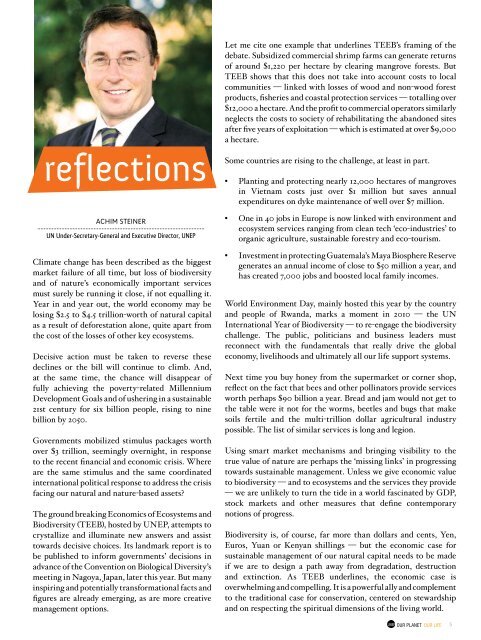BIODIVERSITY - Our Planet
BIODIVERSITY - Our Planet
BIODIVERSITY - Our Planet
You also want an ePaper? Increase the reach of your titles
YUMPU automatically turns print PDFs into web optimized ePapers that Google loves.
Let me cite one example that underlines TEEB’s framing of the<br />
debate. Subsidized commercial shrimp farms can generate returns<br />
of around $1,220 per hectare by clearing mangrove forests. But<br />
TEEB shows that this does not take into account costs to local<br />
communities — linked with losses of wood and non-wood forest<br />
products, fisheries and coastal protection services — totalling over<br />
$12,000 a hectare. And the profit to commercial operators similarly<br />
neglects the costs to society of rehabilitating the abandoned sites<br />
after five years of exploitation — which is estimated at over $9,000<br />
a hectare.<br />
reflections<br />
Achim Steiner<br />
UN Under-Secretary-General and Executive Director, UNEP<br />
Climate change has been described as the biggest<br />
market failure of all time, but loss of biodiversity<br />
and of nature’s economically important services<br />
must surely be running it close, if not equalling it.<br />
Year in and year out, the world economy may be<br />
losing $2.5 to $4.5 trillion-worth of natural capital<br />
as a result of deforestation alone, quite apart from<br />
the cost of the losses of other key ecosystems.<br />
Decisive action must be taken to reverse these<br />
declines or the bill will continue to climb. And,<br />
at the same time, the chance will disappear of<br />
fully achieving the poverty-related Millennium<br />
Development Goals and of ushering in a sustainable<br />
21st century for six billion people, rising to nine<br />
billion by 2050.<br />
Governments mobilized stimulus packages worth<br />
over $3 trillion, seemingly overnight, in response<br />
to the recent financial and economic crisis. Where<br />
are the same stimulus and the same coordinated<br />
international political response to address the crisis<br />
facing our natural and nature-based assets?<br />
The ground breaking Economics of Ecosystems and<br />
Biodiversity (TEEB), hosted by UNEP, attempts to<br />
crystallize and illuminate new answers and assist<br />
towards decisive choices. Its landmark report is to<br />
be published to inform governments’ decisions in<br />
advance of the Convention on Biological Diversity’s<br />
meeting in Nagoya, Japan, later this year. But many<br />
inspiring and potentially transformational facts and<br />
figures are already emerging, as are more creative<br />
management options.<br />
Some countries are rising to the challenge, at least in part.<br />
• Planting and protecting nearly 12,000 hectares of mangroves<br />
in Vietnam costs just over $1 million but saves annual<br />
expenditures on dyke maintenance of well over $7 million.<br />
• One in 40 jobs in Europe is now linked with environment and<br />
ecosystem services ranging from clean tech ‘eco-industries’ to<br />
organic agriculture, sustainable forestry and eco-tourism.<br />
• Investment in protecting Guatemala’s Maya Biosphere Reserve<br />
generates an annual income of close to $50 million a year, and<br />
has created 7,000 jobs and boosted local family incomes.<br />
World Environment Day, mainly hosted this year by the country<br />
and people of Rwanda, marks a moment in 2010 — the UN<br />
International Year of Biodiversity — to re-engage the biodiversity<br />
challenge. The public, politicians and business leaders must<br />
reconnect with the fundamentals that really drive the global<br />
economy, livelihoods and ultimately all our life support systems.<br />
Next time you buy honey from the supermarket or corner shop,<br />
reflect on the fact that bees and other pollinators provide services<br />
worth perhaps $90 billion a year. Bread and jam would not get to<br />
the table were it not for the worms, beetles and bugs that make<br />
soils fertile and the multi-trillion dollar agricultural industry<br />
possible. The list of similar services is long and legion.<br />
Using smart market mechanisms and bringing visibility to the<br />
true value of nature are perhaps the ‘missing links’ in progressing<br />
towards sustainable management. Unless we give economic value<br />
to biodiversity — and to ecosystems and the services they provide<br />
— we are unlikely to turn the tide in a world fascinated by GDP,<br />
stock markets and other measures that define contemporary<br />
notions of progress.<br />
Biodiversity is, of course, far more than dollars and cents, Yen,<br />
Euros, Yuan or Kenyan shillings — but the economic case for<br />
sustainable management of our natural capital needs to be made<br />
if we are to design a path away from degradation, destruction<br />
and extinction. As TEEB underlines, the economic case is<br />
overwhelming and compelling. It is a powerful ally and complement<br />
to the traditional case for conservation, centered on stewardship<br />
and on respecting the spiritual dimensions of the living world.<br />
OUR PLANET OUR LIFE 5

















